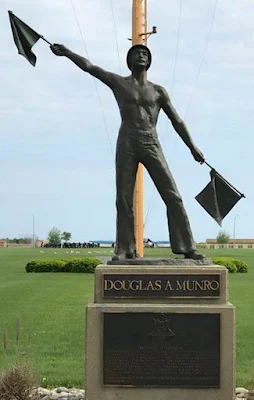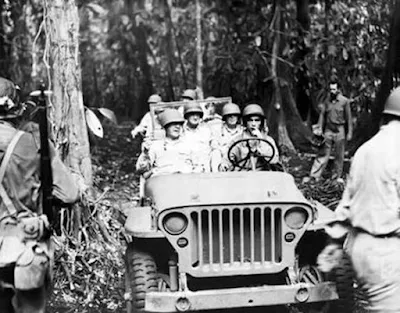 |
| Painting of U.S. Coast Guard personnel evacuating U.S. Marines from near Point Cruz on Guadalcanal under fire during the Second Battle of the Matanikau on September 27, 1942. |
Of the 1,917 U.S. Coast Guardsmen to die as a result of World War II Coast Guard operations, Signalman First Class Douglas A. Munro was the only one awarded the Congressional Medal of Honor. Shortly before his 23rd birthday, Munro volunteered for an amphibious operation to rescue hundreds of his fellow servicemen from a heavily opposed beach in the southern Solomons.
Douglas Albert Munro was born of American parents in Vancouver, British Columbia, on 11 October 1919. He was raised in South Cle Elum, Washington, graduated from Cle Elum High School, and attended the Central Washington College of Education for one year. Munro joined the Coast Guard in 1939, had an outstanding record as an enlisted man, and by 1942 had been promoted through the various ratings to Signalman First Class.
In September 1942, Munro was placed in charge of ten landing craft to land a battalion of U.S. Marines on the Coral Sea island of Guadalcanal. The amphibious operation was successful but the Leathernecks came under increasingly heavy fire from the Japanese defenders. The decision was made to evacuate the Marines. Munro’s detachment, facing strong enemy resistance, succeeded in evacuating the Marines, but the young Coast Guardsman lost his life in the process. Munro was concerned about his fellow countrymen to the very end. His last words were, “Did they get off?”
The story is told in detail in a letter to Munro’s parents, written by U.S.C.G. Commander D. H. Dexter, and in Munro’s citation, written for President Franklin D. Roosevelt.
Guadalcanal, BSI,
2 October 1942
Dear Mr. and Mrs. Munro:
Believe me when I say sincerely that this is a very sad letter for me to write advising you of the death of your son Douglas, but as Commanding Officer of the Unit to which he was attached at the time of his death, I have pride in telling you that he covered himself with honor and I hope Glory, and fulfilled the mission so satisfactorily that almost all of the men he had under his charge returned to their unit and without exception all had praise for your son’s execution of his duties.
It was a year ago last June that Douglas and Raymond Evans came to me and asked if they could be transferred to Captain Ashe’s staff. I succeeded in getting them and since that day have felt that Douglas and Ray Evans have been with me and his loss has left a very decided space which I feel will never be filled so far as I am concerned.
On Sunday the 27th of September an expedition was sent into an area where trouble was to be expected. Douglas was in charge of the ten boats which took the men down. In the latter part of the afternoon, the situation had not developed as had been anticipated and in order to save the expedition it became necessary to send the boats back to evacuate the expedition. Volunteers were called for and true to the highest traditions of the Coast Guard and also to traditions with which you had imbued your son he was among the first to volunteer and was put in charge of the detail. The evacuation was as successful as could be hoped for under fire. But as always happens, the last men to leave the beach are the hardest pressed because they have been acting as the covering agents for the withdrawal of the other men, and your son knowing this so placed himself and his boats so that he could act as the covering agent for the last men, and by this action and successful maneuvers brought back a far greater number of men than had been even hoped for. He received his wound just as the last men were getting in the boats and clearing the beach. Upon regaining consciousness, his only question was “Did they get off?” and so died with a smile on his face and the full knowledge that he successfully accomplished a dangerous mission.
I am sending this to you direct for I feel that you should have the privilege of knowing the facts, but request that you keep it confidential until such time as the official notification is received. I regret having to make this request but feel that it is for the good of all concerned. I consider this a personal letter and not an official report.
In the year and a half that I have known Douglas I have grown to admire him and through him, you. He was the true type of American Manhood that is going to win this war and I hereby promise that I will make all efforts to personally call on you whenever it is my privilege to be near Cle Elum and to pay homage to you both as parents of Douglas.
Sincerely and respectfully,
D. H. Dexter,
Lieutenant Commander, U.S. Coast Guard
Our nation’s highest military decoration, awarded posthumously on 27 May 1943, was presented to Munro’s parents by the President. The citation reads:
For extraordinary heroism and conspicuous gallantry in action above and beyond the call of duty as Officer-in-Charge of a group of Higgins boats, engaged in the evacuation of a Battalion of Marines trapped by enemy Japanese forces at Point Cruz, Guadalcanal, on September 27, 1942. After making preliminary plans for the evacuation of nearly 500 beleaguered Marines, Munro, under constant risk of his life, daringly led five of his small craft toward the shore. As he closed the beach, he signaled the others to land, and then in order to draw the enemy’s fire and protect the heavily loaded boats, he valiantly place his craft with its two small guns as a shield between the beachhead and the Japanese. When the perilous task of evacuation was nearly completed, Munro was killed by enemy fire, but his crew, two of whom were wounded, carried on until the last boat had loaded and cleared the beach. By his outstanding leadership, expert planning, and dauntless devotion to duty, he and his courageous comrades undoubtedly saved the lives of many who otherwise would have perished. He gallantly gave up his life in defense of his country.
Today, Munro is permanently honored at the U.S. Coast Guard Academy at New London, Connecticut. Douglas A. Munro Hall, the enlisted men’s barracks, stands as a tribute to the only Coast Guardsman to ever receive the Congressional Medal of Honor, Signalman First Class Douglas A. Munro.
Sources
R. L. Scheina, U.S. Coast Guard historian.
U.S. Coast Guard Academy.
U.S. Senate Committee on Veteran’s Affairs. Medal of Honor Recipients, 1863-1978. Washington, D.C.: U.S. Government Printing Office, 1979.
 |
| Douglas Albert Munro as a Signalman Third Class, U.S. Coast Guard. |
 |
| Douglas A. Munro, USCG. |
 |
| Douglas A. Munro. |
 |
| The reverse of Munro’s Medal of Honor. |
Douglas Munro, USCG
Douglas Albert Munro (October 11, 1919 – September 27, 1942) is the only member of the United States Coast Guard to have received the Medal of Honor, the United States' highest military award. Munro received the decoration posthumously for his actions as officer-in-charge of a group of landing craft on September 27, 1942, during the September Matanikau action in the Guadalcanal campaign of World War II.
Munro was born on October 11, 1919, in Vancouver, British Columbia, in Canada, to James Munro, originally from California, and Edith Thrower Fairey from Liverpool, England. The Munro family (Douglas, Pat his sister elder by 2 years, and his parents) moved to Vancouver, Washington, in 1922, where his father worked as an electrician for Warren Construction Company. Douglas grew up in South Cle Elum, Washington. He was educated at South Cle Elum Grade School and graduated from Cle Elum High School in 1937. He attended Central Washington College of Education (now known as Central Washington University) for a year before leaving to enlist in the United States Coast Guard in 1939. He had an outstanding record as an enlisted man and was promoted rapidly through the ratings to a signalman, first class.
In the Second Battle of the Matanikau, part of the Guadalcanal Campaign, Munro was in charge of a detachment of ten boats which landed U.S. Marines at the scene. After successfully taking them ashore, he returned his boats to their previously assigned position and almost immediately learned that conditions ashore were different from what had been anticipated and that it was necessary to evacuate the Marines immediately. Munro volunteered for the job and brought the boats to shore under heavy enemy fire, then proceeded to evacuate the men on the beach. When most of them were in the boats, complications arose in evacuating the last men, who Munro realized would be in the greatest danger. He accordingly placed himself and his boats such that they would serve as cover for the last men to leave. Among the Marines evacuated that day was Lt. Col. Lewis B. "Chesty" Puller, USMC. During this action—protecting the men after he had evacuated them—Munro was fatally wounded. He remained conscious long enough to say only four words: "Did they get off?"
Munro is buried at Laurel Hill Memorial Park in Cle Elum, Washington.
Munro's Medal of Honor is on display at the United States Coast Guard Training Center Cape May in Cape May, New Jersey. He received the Navy version of the Medal of Honor because, at the time, the Coast Guard was operating under the Department of the Navy and no separate Coast Guard version of the medal existed. A Coast Guard Medal of Honor was authorized in 1963, but has never been designed or minted.
Born: October 11, 1919, Vancouver, British Columbia, Canada
Died: September 27, 1942 (aged 22), Guadalcanal, Solomon Islands
Place of burial: Laurel Hill Memorial Park Cle Elum, Washington
Allegiance: United States of America
Service/branch: United States Coast Guard
Years of service: 1939–1942
Rank: Signalman First Class
Battles/wars:
World War II
Second Battle of the Matanikau
Awards:
Medal of Honor
Purple Heart
American Defense Service Medal
American Campaign Medal
Asiatic-Pacific Campaign Medal
World War II Victory Medal
Other honors:
Coast Guard: USCGC Munro (WHEC-724)
Coast Guard: USCGC Munro (WMSL-755)
Navy: USS Douglas A. Munro (DE-422)
United States Coast Guard Training Center, Cape May, New Jersey - Munro Hall
United States Coast Guard Academy, New London, Connecticut - Munro Hall
On July 8, 2013, Rep. Eleanor Holmes Norton introduced H.R. 2611 (An act to designate the Douglas A. Munro Coast Guard Headquarters Building (H.R. 2611; 113th Congress)) to name the new Coast Guard headquarters after Munro.







































